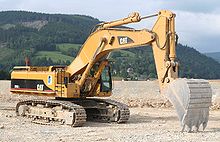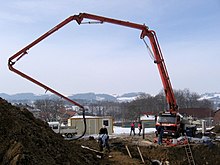Construction site equipment
The term construction site equipment includes all production, transport, storage and other equipment that is required to erect a structure on the construction site . Specifically, these are devices, machines, buildings for accommodating workers, weather-sensitive construction and auxiliary building materials, spare parts and the like, processing and storage areas as well as traffic areas.
Influencing factors of the construction site equipment
The scope and type of construction site equipment is largely determined by the following influencing variables:
- Size of the building object
- Type of structure ( construction )
- construction time
- Weather conditions
- local influences (terrain shape, terrain size, neighboring buildings, etc.)
- internal influences ( availability of construction equipment )
Planning the construction site equipment
Process of site equipment planning
The construction site equipment planning process is usually divided into three phases.
- Planning through to the award of the contract
In order to determine the offer price , the construction methods and thus the construction process must be determined. For this, a rough concept of the construction site equipment must be created in order to determine the basis of the calculation . This includes the service life as well as performance and cost estimates for workers and equipment .
- Planning after placing the order up to the start of construction
This section contains the planning of the construction site equipment ready for execution. The concept that was created during the planning before the contract was awarded will now be further completed, specified or possibly revised.
- Planning after the start of construction
Phase 3 occurs due to changes in the construction process, changed boundary conditions or, for example, changed construction methods. Only in the context of the construction progress is information available that allows detailed planning and updating of the construction site facility planning.
Individual elements of the construction site equipment
building
The buildings include
- Accommodation as break rooms and living quarters,
- Sanitary rooms possibly also a first aid room ,
- Magazines for construction materials , supplies and tools,
- Site offices ,
- Laboratories (e.g. concrete laboratory and earthwork laboratory ).
Media supply
This includes the supply of energy and water, the connection to a communication network and the disposal of precipitation and waste water . If the construction site cannot be connected to the public power supply, self-generation with generators is required.
Construction site security
- Site fence to prevent unauthorized access to the construction site and to protect against theft.
- Securing traffic routes to protect the construction site from the dangers of traffic on adjacent roads (e.g. guardrails , guide walls or guide beacons ). Objectives of the measures: protection of construction workers, warning and protection of road users, separation of traffic function and construction work.
- Water protection is often necessary in floodplains and in the vicinity of bodies of water when storing water-polluting liquids.
- Tree protection is required by public law.
- Line protection to avoid line damage. Knowledge of the routing of lines is required for this. Cranes require an appropriate safety distance from high-voltage lines .
- Neighborhood protection: Neighboring properties or property must not be impaired or damaged by construction activities.
- Fire protection : Dangers on the construction site when storing flammable substances, packaging material, pressurized gas containers and fireplaces (e.g. gas heating , bitumen cooker ). Depending on the dimensions and use of the fire-endangered materials, workplaces must be equipped with a sufficiently large number of fire extinguishing systems.
- Weather protection: People, materials, equipment as well as unfinished buildings must be protected from moisture, frost and wind.
Hoists and conveyors
The following hoists and conveyors are mainly used in the construction site equipment:
These devices are very important elements of the construction site equipment and are of great importance for economic success. When planning, the work area, the appropriate work location and the dimensions of the devices must be taken into account. If the devices are used and implemented incorrectly, this can lead to a safety and economic risk.
Traffic areas and transport routes
The traffic areas and transport routes to, from and on construction sites are to be laid out and connected to the public transport network, taking into account the local conditions and the requirements imposed by the construction project, so that an orderly and clear flow of traffic and transport is possible.
The following areas and paths are to be planned:
- Construction site access
- Construction roads , construction paths and parking spaces
- Storage areas
Avoid soiling and damaging public traffic areas.
Working and protective scaffolding
Scaffolding is inevitable on construction sites these days. You have to guarantee both the intended use and the security of the workers.
Waste disposal
In order to ensure economical waste disposal, the dimensioning of the collecting container plays an important role. The type and size of the collection container depends on the expected amount of waste, the degree of waste separation and the available space.
Types of site equipment
The construction site equipment is of course not only part of the building construction , but also of the tunnel , road , pipeline , sewer , railway and earthworks . While the construction sites in building construction are stationary and fixed, the installations for earthworks generally have to be mobile. This not only applies to sewer and road construction, but also to excavations, where earthworks only make up a small part of the building volume. So z. B. instead of permanently installed tool, team, office and material barracks, mobile barracks carts, tool trailers and containers are used.
The construction site facilities in these areas differ, among other things, in the construction equipment . In earthworks , for example, many different excavators are used, in building construction hoists and in traffic route construction pavers and rollers . For construction problems in sewer and pipeline construction find bone , compaction equipment or excavators their use.
When building a tunnel , machines and construction methods for driving a tunnel are selected depending on the soil and the groundwater conditions. Various tunnel boring machines are used here.
The construction site facility plan
The location and stand areas of all elements are specified in the site equipment plan. The starting point for construction site equipment plans should, if possible, be general plans by the architect, and for construction sites with a gradient of more than 2%, also measured height plans of the construction site. The individual elements of the construction site equipment are entered true to scale in this site plan . Pay attention to the following:
- The most important dimensions of all elements must be entered. The dimensioning must be carried out so that the construction site equipment can then be set up in the open area.
- The individual elements must be clearly identified by symbols and labels.
- If more precise information is required for the installation of individual systems, detailed drawings of 1:50, 1:20, 1:10 or 1: 5 must be shown with all the necessary information.
The plan format must be selected so that all information can be displayed. For this purpose, a scale of 1: 100 is usually used for smaller objects or 1: 200 for larger objects. Exceptions are large, longitudinally oriented objects in civil engineering , road construction and track construction . In these cases, the site equipment plan on a scale of 1: 500 is required.
Construction site setup costs
The following costs are incurred when setting up (in the narrower sense) a construction site:
- Charging costs for equipment, accommodation, construction vehicles, containers, tools, scaffolding and formwork material, auxiliary materials, etc.
- Freight costs for freight transport,
- Set-up, conversion and dismantling costs for devices, containers, media, driveways, paths, safety devices, etc.
However, if the "construction site facility" is a service item in the specifications, the costs of the construction site facility also include, for example:
- Depreciation, interest and repair of storage devices ,
- Energy costs of the construction site,
- Rents for construction site equipment,
- Cleaning costs for the construction sites
and depending on the allocation of costs in the calculation
- Construction management costs ( site manager , foreman ),
- Insurance.
If no service item is provided for the construction site equipment in the specification of services, the costs of the construction site equipment are recorded under the overhead costs of the construction site .
literature
- Rainer Schach , Jens Otto: Construction site equipment: Basics - Planning - Practical advice - Regulations and rules. 2nd edition , Vieweg + Teubner Verlag, 2011, ISBN 978-3-8348-1399-2 .
- Fritz Berner , Bernd Kochendörfer, Rainer Schach: Basics of construction management. Volume 2: Construction planning. In: Fritz Berner, Bernd Kochendörfer (Hrsg.): Guide of the construction company and the construction industry. BG Teubner Verlag / GWV Fachverlage, Wiesbaden 2008, ISBN 978-3-8351-0234-7 .
- Drees , Reiff: The construction site equipment. Werner-Verlag, 1971, ISBN 3-8041-1305-2 .
- Drees, Paul: Calculation of building prices. 10th edition, Bauwerk, Berlin 2008, ISBN 978-3-89932-211-8 .
- Fritz Berner: Safety and health protection on construction sites in Germany and Austria. Bauwerk, Berlin 2000, ISBN 3-934369-29-4 .
Web links
Individual evidence
- ^ Drees / Reiff: The construction site equipment . Werner-Verlag, 1971, ISBN 3-8041-1305-2 . S. VIII.
- ↑ Fritz Berner , Bernd Kochendörfer, Rainer Schach: Fundamentals of construction management. Volume 2: Construction planning In: Fritz Berner, Bernd Kochendörfer (Hrsg.): Guidelines for construction operations and the construction industry . BG Teubner Verlag / GWV Fachverlage GmbH, Wiesbaden 2008, ISBN 978-3-8351-0234-7 , p. 234.
- ↑ http://www.bauliteratur.ch/tiefbau/völker_tiefbauarbeiten.htm
- ^ Rainer Schach, Jens Otto: Construction site equipment: Basics - Planning - Practical advice - Regulations and rules . Vieweg + Teubner Verlag, 2011, ISBN 978-3-8348-1399-2 , p. 320.







